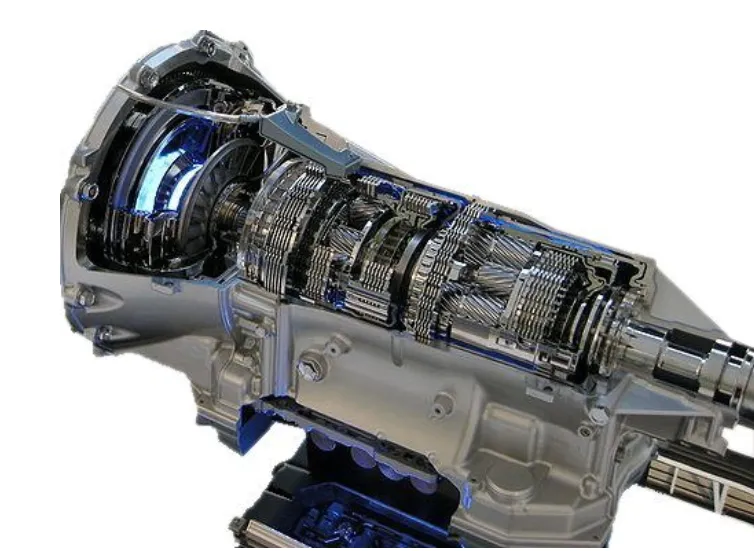Mon - Fri: 8am - 5pm, Sat - Sun: Closed

6-36 Month Warranties
We Ship Local.
Hablamos Español.
Connect with
Automatic GM Transmissions — Everything You Need to Know
Comprehensive Guide to Automatic GM Transmissions
If you're fascinated by the progress of automotive technology, consider how far GM has come. In the 1950s, the Powerglide transmission was a simple two-speed system, a far cry from today's advanced 10-speed transmissions like the 10L90E, built to handle the raw power of a 650-horsepower Camaro ZL1.
Today, we’re diving into GM’s automatic transmission lineup, from the Powerglide’s modest beginnings to the highly sophisticated 10L90E. Along the way, we’ll also break down GM’s transmission naming system, making it easier to understand these alphanumeric model codes. Get ready to explore how GM’s automatic transmissions have evolved over time.

The Powerglide Era
Debuting in the 1950s, the Powerglide was GM’s first automatic transmission designed for budget-friendly vehicles, setting a foundation for simpler, more accessible driving. Initially, it didn’t shift gears automatically—drivers had to manually switch from “Low” to “Drive” around 30-40 mph.
By 1953, GM introduced an automatic upshifting feature, significantly improving drivability. This upgrade made the Powerglide a key player in GM’s transition toward fully automatic transmissions, catering to drivers looking for ease and convenience.
The Powerglide was widely used in Chevrolet models, helping it gain popularity. Initially made with a cast-iron casing, it later transitioned to a lightweight aluminum design in the 1960s, making it a perfect fit for smaller vehicles like the Chevy II. Its durability and simple design kept it in production into the early 1970s. Over time, it became a favorite among drag racers due to its reliability and adaptability, proving its usefulness beyond daily driving.
Turbo-Hydramatic Series
Turbo-Hydramatic 350 (TH350)
Introduced in the late 1960s, the TH350 marked a major step forward for GM. This three-speed transmission was valued for its toughness and versatility, making it a go-to option for various vehicles, from sedans to light trucks. Its ability to handle moderate torque loads contributed to its widespread use across GM’s lineup.
Turbo-Hydramatic 400 (TH400)
Designed alongside the TH350, the TH400 was built to handle even more power. Its three-speed configuration and reinforced design made it a top choice for larger vehicles requiring higher torque capacity. Found in performance cars, luxury vehicles, and even racing applications, the TH400 became known for its durability and ability to handle demanding conditions.

The Overdrive Revolution
THM200-4R
As fuel efficiency became a priority in the early 1980s, GM introduced the THM200-4R. This four-speed automatic transmission featured an overdrive gear, allowing for improved fuel economy and quieter operation on highways. It gained traction in rear-wheel-drive GM vehicles, offering a mix of efficiency and performance.
THM700-R4
Another major development of the 1980s was the THM700-R4, which also featured four speeds and an overdrive gear. Built to handle more torque than its predecessors, this transmission was well-suited for performance cars and light trucks. One of its standout features was its lock-up torque converter, which improved fuel efficiency and reduced heat, ensuring smoother gear transitions and better overall performance.
Electronic Control: The Advent of Modern Transmissions
4L60E
The 1990s ushered in a new era with the electronically controlled 4L60E. Building on the 700-R4’s foundation, this transmission featured electronic solenoids to regulate shifting, enhancing precision and responsiveness. It quickly became a staple in GM’s lineup, fitting everything from light trucks to performance cars. The 4L60E’s adaptability made it one of GM’s most widely used automatic transmissions.
4L80E
Following the success of the 4L60E, GM introduced the 4L80E, designed for more demanding applications. Structurally more robust, this transmission could handle higher torque loads, making it ideal for heavy-duty trucks and high-performance vehicles. Its electronically controlled shifting allowed for smoother transitions, proving its value in both commercial and high-performance automotive sectors.
Recent Advancements
6-Speed 6L80E
The mid-2000s saw the debut of the 6L80E, bringing six-speed technology to GM’s transmission lineup. This upgrade allowed for improved fuel efficiency, smoother acceleration, and better adaptability across a range of vehicle types, from SUVs to performance cars.
8-Speed 8L90E
Building on the success of the 6L80E, GM introduced the 8L90E, adding two more gears for even greater precision and control. The additional gear ratios optimized power delivery while enhancing fuel economy, particularly in high-performance vehicles.
10-Speed 10L90E
At the peak of GM’s transmission evolution sits the 10L90E, a ten-speed automatic designed for top-tier performance. Found in some of GM’s most powerful vehicles, this transmission delivers fast, smooth shifts while maintaining fuel efficiency. Its advanced design ensures maximum performance without sacrificing everyday drivability.
Understanding Alphanumeric Designations
GM’s transmission model names aren’t random combinations of letters and numbers—they follow a specific logic. The first number indicates the number of forward gears, while the letter “L” signifies a longitudinal layout for rear-wheel-drive applications. The final numbers indicate torque capacity, helping determine which transmission is best suited for different vehicles.

Let’s Wrap Things Up
From the simple two-speed Powerglide to the cutting-edge 10L90E, GM has continuously refined its automatic transmissions to balance power, efficiency, and reliability. Each innovation reflects GM’s commitment to advancing automotive technology while ensuring a smoother, more enjoyable driving experience.

Get our latest news and promos
QUALITY ASSURED


SATISFACTION GUARANTEED

UNPARALLELED SUPPORT
Houston Engines
Proud Member



Social Media
Payments Accepted
Ship Via











